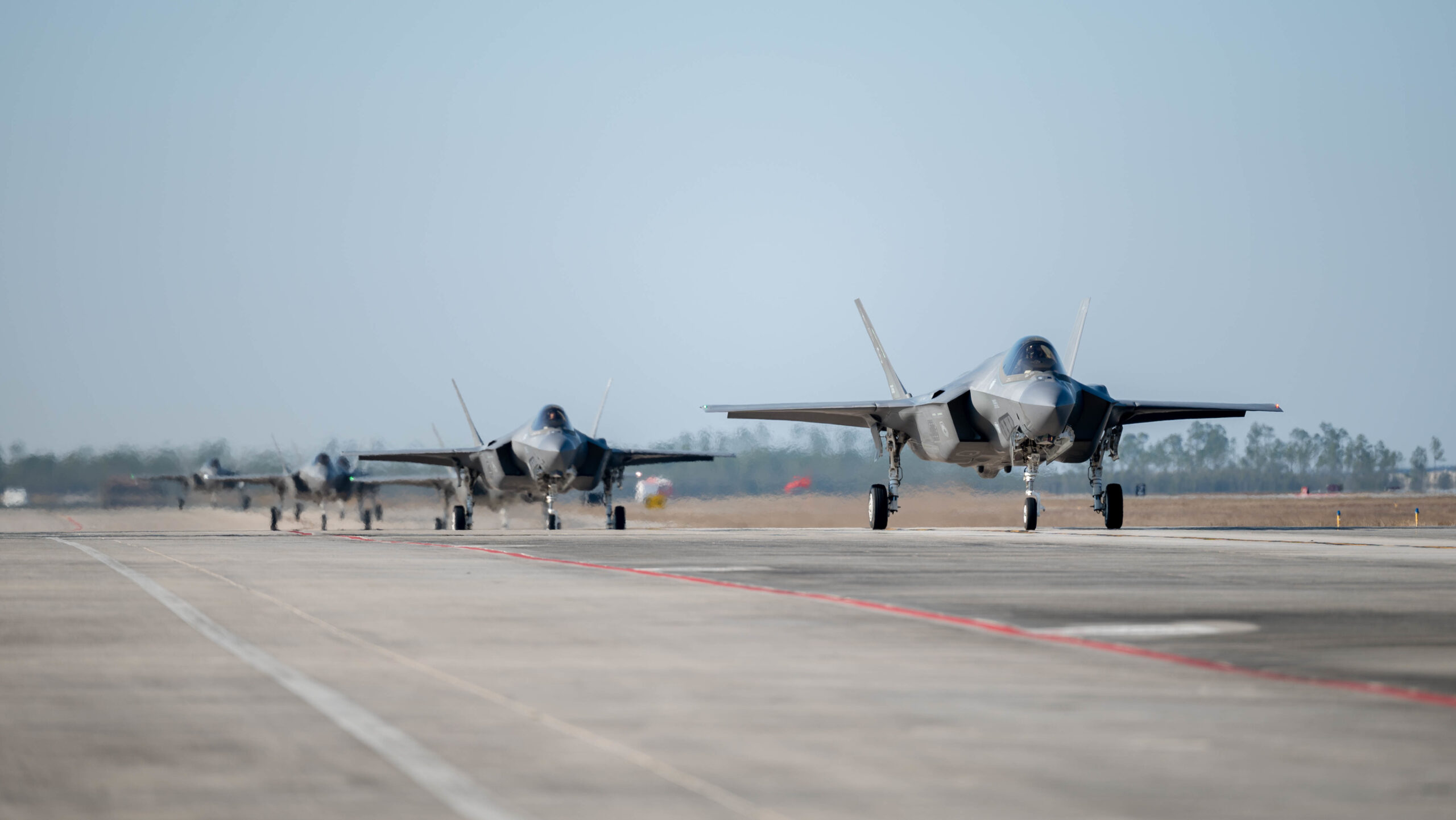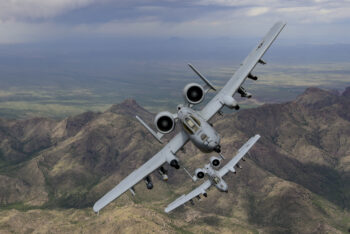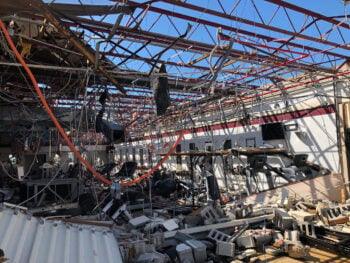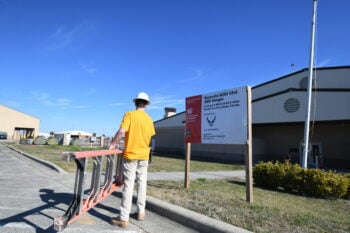
F-35As assigned to the 308th Fighter Squadron, Luke Air Force Base, Arizona, taxi the flight line at Tyndall AFB, Florida, Jan. 27, 2022. Tyndall is slated to receive its first F-35 in 2023. (U.S. Air Force/Airman 1st Class Anabel Del Valle)
TYNDALL AIR FORCE BASE, Fla.: After Hurricane Michael devastated Tyndall Air Force Base in 2018, the installation was given a lifeline when the service announced plans to base three F-35 Joint Strike Fighter squadrons there.
But as construction ramps up and the base begins to visibly bounce bank, an old political scuffle thousands of miles away is threatening Tyndall’s F-35 timeline and forcing the Air Force to scramble to find maintainers for the world’s most advanced fighter — including through options that would hinder F-35 operations at other bases, a senior Air Force official tells Breaking Defense.
While the Air Force originally intended to source maintainers for Tyndall’s F-35s from the A-10 squadrons headed for the boneyard, Arizona lawmakers fought tooth and nail to preserve the Warthog inventory, preventing the Air Force from being able to divest 42 A-10s in fiscal 2022, 35 of which were slated to come from Davis-Monthan AFB, Ariz.
Smarting from that loss, the service refrained from an attempt to divest any of Arizona’s A-10s in its FY23 budget request. And as a result, it’s now unclear exactly where Tyndall will find a maintainer corps for its new F-35s.
In a statement to Breaking Defense, Lt. Gen. David Nahom, the Air Force’s deputy chief of staff for plans and programs, said that Tyndall remains on track to begin the beddown of its first F-35 squadron in September 2023, with the service “actively working to find the experienced personnel needed to accept the first F-35 aircraft.”
However, manning the second and third F-35 squadrons could be more of a challenge — one that may come at the expense of other F-35 bases.
“Until the Air Force can source the experienced personnel required for the three combat-coded squadrons planned for Tyndall AFB, the Air Force may need to take experienced pilots/maintainers from other currently operating F-35 locations, leaving them undermanned,” Nahom said.
That course of action, he said, would create “significant risk” for the Air Force’s existing combat-coded F-35 squadrons at Hill AFB, Utah, and Eielson AFB, Alaska, as well as the training squadrons at Luke AFB, Ariz., and Eglin AFB, Fla.

Two A-10C Thunderbolt IIs fly in formation over southern Arizona, April 29, 2019. (U.S. Air Force/Staff Sgt. Betty R. Chevalier)
“This could impact the ability for F-35 units to train the next generation of F-35 pilots/maintainers, train pilots/maintainers trying to transition current legacy fighter units to the F-35, as well as quickly respond to contingency operations in the future,” Nahom said.
No Money, More Problems
As the Air Force weens itself off legacy platforms and begins to beddown new aircraft like the F-35, it finds itself with a shortage of “several thousand maintainers,” Nahom said.
When the Air Force was prohibited from reducing its A-10 inventory in FY21 and FY22 from 281 to 218 aircraft, the service was required to keep about 920 people tied to the Warthog instead of being able to redirect those personnel to other billets.
Congress hoped to free up Air Force maintainers for the F-35 by adding $185 million for F-35 sustainment and $70 million for A-10 sustainment in the fiscal 2022 appropriations bill. Sources on Capitol Hill told Breaking Defense that lawmakers believed that funding could alleviate pressure by helping to cover contractor-provided maintenance for the A-10. The Air Force has adopted that strategy in the past, contracting with DynCorp — now known as Amentum — for A-10 maintenance services until March 2020.
Instead, the Air Force now plans to use the F-35 funding to pay for “spares, consumables, sustaining engineering, software maintenance, simulators, and training specific to the F-35,” while the A-10 sustainment funds are needed to maintain the 42 planes the service was not allowed to retire.
“In short, these funds are not available to help mitigate the maintenance shortfall at Tyndall,” Nahom said.
RELATED: Air Force seeks startups to build high tech bases of the future
Although the Air Force is only now acknowledging the potential delay to the F-35 beddown at Tyndall, the issue has been discussed among lawmakers on Capitol Hill for more than a year.
Last summer, Sen. Marco Rubio, R-Fla., wrote a letter to the leaders of the Senate Armed Services Committee expressing concern that language in the FY22 National Defense Authorization Act prohibiting the divestment of the A-10 could come at the expense of Tyndall’s F-35 beddown plan. Rubio reiterated those concerns in a statement to Breaking Defense.
“The delays are unfortunate, but I will continue to work with the Air Force to carry out their commitment to make Tyndall the F-35 base of the future,” he said.
Breaking Defense reached out to a trio of the biggest A-10 defenders — Sens. Mark Kelly and Kyrsten Sinema, as well as Rep. Ann Kirkpatrick, all of Arizona — for this report. None of the lawmakers responded to a request for comment, but have repeatedly voiced concerns about the Air Force’s A-10 retirement plan — specifically that the F-35 and other fighters could not accomplish elements of the close air support mission currently performed by the Warthog.
Tyndall In Transition
Despite the Air Force’s internal concerns about how it will be able to source maintainers for Tyndall’s F-35s, the base is propelling forward with a $4.9 billion effort that is set to revamp its facilities to withstand future disasters and bring manned fighters back to the skies above Panama City, Fla.
The road there has been uncertain every step of the way.

The aftermath of Hurricane Michael at Tyndall Air Force Base, Fla. (Courtesy USAF)
After Hurricane Michael rampaged through the Florida panhandle in October 2018, the base — whose 325th Fighter Wing was home to one operational F-22 squadron and one F-22 training squadron — was left a ruin of its former self.
In photos taken after the Category 5 storm, the base appeared flattened, with roofs torn off hangars and many of its buildings completely demolished. Some of the F-22s based there were relocated ahead of time, but rumors circulated about whether Tyndall would be able to operate the dozen or so F-22s that were left behind during the hurricane and had been damaged, or whether the Air Force would ultimately seek to completely shut down the base.
In December 2018, Heather Wilson, who at the time was the Air Force’s top civilian, announced that the Air Force would seek to rebuild Tyndall as the site of three F-35 squadrons. Tyndall’s operational F-22s from the 95th Fighter Squadron would be sent to other F-22 bases, and the service would evaluate where to station the F-22 basic training mission.
RELATED: Hurricane Michael hits Coast Guard’s largest program, leaving devastation
Now, nearly four years after Hurricane Michael, Tyndall finds itself in a transitional stage. The 95th’s F-22s have been parceled out to other F-22 squadrons. The F-22 training mission will eventually move to Joint Base Langley Eustis in Virginia, but for now pilots do academic and simulator training at Tyndall before transferring to neighboring Eglin Air Force Base, Fla. — about two hours west — to conduct the flying potion of the syllabus.
Most importantly, the centerpiece of the rebuilding effort is just now starting to take shape: the eventual beddown of three squadrons of Lockheed Martin F-35A conventional takeoff and landing models, each comprised of 24 jets.
In May, the Army Corps of Engineers awarded a $532 million contract to Hensel Phelps to construct 11 new facilities that will eventually support Tyndall’s F-35s, including:
- Three hangars
- Squadron maintenance complex
- Group headquarters building
- Simulator facility
- Aircraft support equipment storage
- Maintenance fuel cell hangar
- Weapons load training hangar
- Parking apron
- Corrosion control facility
Tyndall’s program management office, which is leading the rebuild effort, has broken down major construction projects into 12 zones, with the new F-35 facilities being built in “zone 1” on the east side of the base near the flightline.
While construction is set to begin this summer, none of the buildings will be ready before the first F-35s are scheduled to arrive in September 2023, said Col. Greg Moseley, commander of the 325th Fighter Wing. The first pilots and maintainers will arrive even sooner — likely by the end of the year or beginning of 2023.
“It’s not like the airplanes show up in the overhead and everybody shows up. There’s a lot of beddown that has to happen well in front of September,” he told Breaking Defense during a May visit to Tyndall AFB.
“We had to build out a temporary facility game plan. … If you’re coming in with 325th to support the F-35, we know exactly where you will sit, what computer you’ll be on, and what phone line you’re going to have. And it is down to that detail right now.”

A contractor carries a ladder towards a construction site at Tyndall Air Force Base, Florida,
March 2, 2022. Once completed, the renovated facility is planned to house the 325th
Operations Support Squadron and will facilitate support for the F-35A Lightning II mission set.
(U.S. Air Force photo by 2nd Lt. Joe Harclerode)
The first aircraft hangar, simulation building and aircraft equipment storage are the biggest priority construction projects for the F-35 beddown, and will be built first, said Col Travis Leighton, director of Tyndall’s base construction program management office.
But to bridge the gap until those projects are completed, Tyndall plans to repurpose several existing buildings near the flight line that were not heavily damaged by Hurricane Michael and can be fixed by the base’s civil engineering team, Moseley said. For instance, an old facility previously used to support F-15 engines will be used to store F-35 spare parts.
Permanent hangar space is limited, but an existing hangar — Building 290 — is being repaired so that it can house up to six F-35s, and the base has also built expeditionary aircraft hangar shelters where F-35s can be stored and repaired, Moseley said.
By August, Tyndall hopes to finalize the design for permanent sun shelters along the flight apron where aircraft will be refueled and loaded with weapons, he said. Those shelters will provide protection from lightning or other weather conditions, and will come equipped with WiFi to allow maintainers to use the F-35’s logistics system.
Tyndall’s first F-35 squadron, which will likely be designated the 95th Fighter Squadron, is set to become combat ready by 2025, and the last of the base’s F-35s will arrive by 2028, Moseley said — assuming the maintainer problem is solved.
But at the same time Tyndall is ramping up F-35 operations, it will be juggling elements of the F-22 training mission. F-22 simulator and academic training will continue to take place at Tyndall until at least 2026 or 2027, when Langley gets its own simulator and training facilities constructed, Mosely said.
The future of Tyndall’s remaining F-22s — which are currently based at Eglin AFB — is currently up in the air.
As part of its FY23 budget request, the Air Force proposed retiring the 30 F-22s owned by Tyndall, which are the older and less advanced Block 20 configuration. If Congress rejects that plan, however, those jets will eventually transition to Langley.
Before Michael, And After Michael
Despite the lingering signs of the damage caused by Hurricane Michael — the trailers and temporary shelters where many of Tyndall’s personnel still work, the splinters of broken trees littering the skyline — the base finally seems to be bouncing back.
The first three new construction projects are all slated to be complete by the end of the year, including a new simulation building to train air battle managers, a fire station and a child care center. And although Tyndall is no longer home to any F-22s, the base still hosts major air-to-air exercises such as Checkered Flag, which took place in May.
“There’s always going to be ‘before Michael’ and ‘after Michael’ here at Tyndall,” said Brian Stahl, deputy base civil engineer. (Stahl was present at Tyndall when the hurricane struck, and in 2019 told local news station WMBB he watched an antenna tower fall into the building he was working in.)
But while there is a “level of excitement” within the local community about the rebuild, the return of fighter jets to the base will be a turning point, Stahl said.
“Every once in a while, I run into people downtown and they say, ‘Well you know ever since they closed Tyndall…’ because they’re not hearing planes fly,” he said. “Once we start getting the F-35s here, and you see planes every day out here flying, I think it’s going to change people’s opinion of what’s going on at Tyndall.”
Norway’s top officer on his ‘biggest challenge,’ next frigate and new NATO neighbors
Gen. Eirik Kristoffersen, Norway’s Chief of Defense, talks to Breaking Defense about his plans for spending on new frigates and subs, the challenges of upgrading Norway’s “digital backbone” and refilling the military’s stocks.


























